It looks like you're using an Ad Blocker.
Please white-list or disable AboveTopSecret.com in your ad-blocking tool.
Thank you.
Some features of ATS will be disabled while you continue to use an ad-blocker.
share:
a reply to: Byrd
You see Nimru the winged panther/leopard on this seal from the time of Gudea, late third millenium, it is most commonly seen on Northern Mesopotamian seals of the mid second millenia, but does trace back earlier, and is very often seen with mouth wide open and a stream issuing forth from it, as on the Mitanni seals.
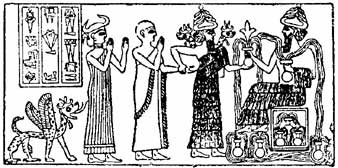
The winged Panther was often seen in the context of the axis of the tree of life, as a constellation along it, also Andromeda the stag and probably Capella the she goat.
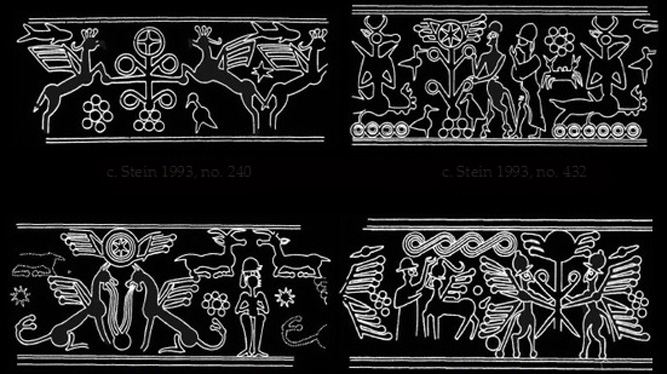
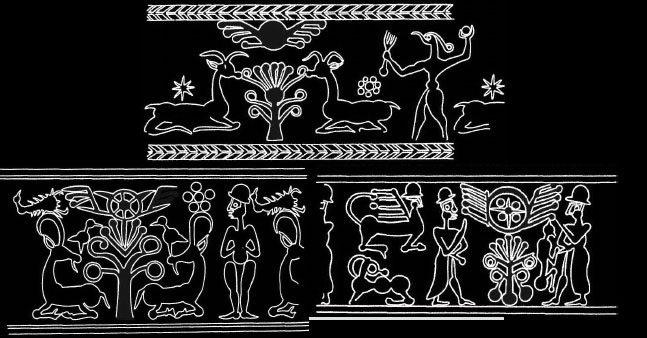
A good indication of how widespread these were from here;
Winged disks and sacred trees
Nimru in it's sense of storm Demon though did tend to take on something of a hybrid chimera like appearance often.
The impact in the Marshlands certainly couldn't have affected mountains, again multiple fragment impacts, the mountain obviously thought it was very big and tough until it crossed Ninurta...
a reply to: punkinworks10
Does that paper take into consideration 'the exploits of Ninurta' text...?
You see Nimru the winged panther/leopard on this seal from the time of Gudea, late third millenium, it is most commonly seen on Northern Mesopotamian seals of the mid second millenia, but does trace back earlier, and is very often seen with mouth wide open and a stream issuing forth from it, as on the Mitanni seals.

The winged Panther was often seen in the context of the axis of the tree of life, as a constellation along it, also Andromeda the stag and probably Capella the she goat.


A good indication of how widespread these were from here;
Winged disks and sacred trees
Nimru in it's sense of storm Demon though did tend to take on something of a hybrid chimera like appearance often.
The impact in the Marshlands certainly couldn't have affected mountains, again multiple fragment impacts, the mountain obviously thought it was very big and tough until it crossed Ninurta...
a reply to: punkinworks10
Does that paper take into consideration 'the exploits of Ninurta' text...?
edit on Kpm22933vAmerica/ChicagoWednesday0329 by Kantzveldt because:
(no reason given)
Star and flag for you, this is awesomegood reading!
Need to read it in full later, excuse me for sounding foolish but if it hit a mountain, wouldnt there be at least a plateu or a large ridge/caldera with a mountainous(pun intended) field of ejecta?
Seems like an eroded basin crater
Need to read it in full later, excuse me for sounding foolish but if it hit a mountain, wouldnt there be at least a plateu or a large ridge/caldera with a mountainous(pun intended) field of ejecta?
Seems like an eroded basin crater
a reply to: punkinworks10
Do forgive my skepticism here, but the paper is available only for expensive download, doesn't say WHERE it was first published and does not show up on a Google Scholar search and doesn't explain the two authors' backgrounds. They seem to be Macintosh applications programmers.
I appreciate the link but am reluctant to trust it given those parameters. Do you have anything linking them to their current research, etc?
Do forgive my skepticism here, but the paper is available only for expensive download, doesn't say WHERE it was first published and does not show up on a Google Scholar search and doesn't explain the two authors' backgrounds. They seem to be Macintosh applications programmers.
I appreciate the link but am reluctant to trust it given those parameters. Do you have anything linking them to their current research, etc?
originally posted by: Kantzveldt
a reply to: Byrd
You see Nimru the winged panther/leopard on this seal from the time of Gudea, late third millenium, it is most commonly seen on Northern Mesopotamian seals of the mid second millenia, but does trace back earlier, and is very often seen with mouth wide open and a stream issuing forth from it, as on the Mitanni seals.
Excellent. Very solid, and I agree that you've made a correct identification there! Let's see if we can find the location and identity of that seal, because your corrected identification (if there is no other published material post-1995 on it) needs to be published.
Mind you, I'm not convinced about the other, but your identification there is right on the mark as far as I can tell.
edit on 3-2-2016 by Byrd
because: (no reason given)
a reply to: Byrd
Byrd,
I can respect those concerns,
I forgot that this particular paper was behind a pay wall.
Here it is,
www.dropbox.com...
One of the authors is a climate modeling guy and
I've seen Lemke's name on several papers dealing with climatology and the ancient near east /south western Asia.
Here are three other papers, concerning the same subjects.
www.dropbox.com...
Byrd,
I can respect those concerns,
I forgot that this particular paper was behind a pay wall.
Here it is,
www.dropbox.com...
One of the authors is a climate modeling guy and
I've seen Lemke's name on several papers dealing with climatology and the ancient near east /south western Asia.
Here are three other papers, concerning the same subjects.
www.dropbox.com...
a reply to: punkinworks10
For what ever reason the links I previously posted won't open as pdf on the app.
Click on the download icon at top right and the pdf will download.
For what ever reason the links I previously posted won't open as pdf on the app.
Click on the download icon at top right and the pdf will download.
edit on p0000002k18232016Wed, 03 Feb 2016 19:18:00 -0600k by punkinworks10 because: (no reason given)
a reply to: Kantzveldt
Thank you for pointing this out, and giving such a detail summary of these accounts, and what they seem to state.
Thank you for pointing this out, and giving such a detail summary of these accounts, and what they seem to state.
a reply to: Kantzveldt
Whaaaaaat.
First thing that comes to mind?
If it happened then, it could happen again.
So scary!
Ty for sharing this.
Whaaaaaat.
First thing that comes to mind?
If it happened then, it could happen again.
So scary!
Ty for sharing this.
I love looking at the tablets. I got my first Sitchin book back in the 70s, I couldn't understand it at first, lots of names and places. After all of
this time the tablets are just as amazing to me. I am impressed by Your knowledge of the Sumerian culture.
Fantastic post, OP, and well researched.
There is plenty of evidence.
Expeditions should uncover shocked quartz, which would be definitive. I looks like they have just about everything else, including micro-spherules in the layering.
One can imagine a multiple hit as most asteroids that can produce a 3-4 mile wide crater travel with small friends.
I will bet there will be a lot more scientific interest that will produce some great data.
It is said that nothing lived within a 50-80 mile radius of the Winslow crater, 50k years old in Flagstaff, AZ. That crater is 3/4 mile wide. Imagine what the devastation would have been for one that is 5 times larger.
There is plenty of evidence.
Expeditions should uncover shocked quartz, which would be definitive. I looks like they have just about everything else, including micro-spherules in the layering.
One can imagine a multiple hit as most asteroids that can produce a 3-4 mile wide crater travel with small friends.
I will bet there will be a lot more scientific interest that will produce some great data.
It is said that nothing lived within a 50-80 mile radius of the Winslow crater, 50k years old in Flagstaff, AZ. That crater is 3/4 mile wide. Imagine what the devastation would have been for one that is 5 times larger.
edit on 3-2-2016 by charlyv because: content
edit on
3-2-2016 by charlyv because: spelling , where caught
originally posted by: Byrd
originally posted by: Kantzveldt
a reply to: Byrd
You see Nimru the winged panther/leopard on this seal from the time of Gudea, late third millenium, it is most commonly seen on Northern Mesopotamian seals of the mid second millenia, but does trace back earlier, and is very often seen with mouth wide open and a stream issuing forth from it, as on the Mitanni seals.
Excellent. Very solid, and I agree that you've made a correct identification there! Let's see if we can find the location and identity of that seal, because your corrected identification (if there is no other published material post-1995 on it) needs to be published.
Mind you, I'm not convinced about the other, but your identification there is right on the mark as far as I can tell.
I don't know whether either of you noticed his clawed, eagle-like feet...
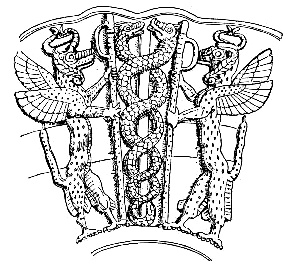
...exactly as depicted above on the libation vase of Gudea.
The mušḫuššu (𒈲𒄭𒄊; formerly also read as sirrušu, sirrush) is a creature depicted on the reconstructed Ishtar Gate of the city of Babylon, dating to the 6th century B.C. As depicted, it is a mythological hybrid: a scaly dragon with hind legs resembling the talons of an eagle, feline forelegs, a long neck and tail, a horned head, a snake-like tongue, and a crest.
en.wikipedia.org...
It seems to have been interpreted here as a "winged leopard (griffin)" though...
The seal of Gudea: Gudea, with shaven head, is accompanied by a minor female diety. He is led by his personal god, Ningishzida, into the presence of Enlil, the chief Sumerian god. Wind pours forth from of the jars held by Enlil, signifying that he is the god of the winds. The winged leopard (griffin) is a mythological creature associated with Ningishzida, The horned helmets, worn even by the griffins, indicates divine status (the more horns the higher the rank). The writing in the background translates as: "Gudea, Ensi [ruler], of Lagash".
sumerianshakespeare.com...
This is simply fascinating, while doing some basic research I came across this:
www.news.cornell.edu...
Using “dendro radiocarbon wiggle matching" they were able to pinpoint a rough date of when this event occurred, 2200 B.C.
Right around the same time as this paper suggests..
www.news.cornell.edu...
Using “dendro radiocarbon wiggle matching" they were able to pinpoint a rough date of when this event occurred, 2200 B.C.
Right around the same time as this paper suggests..
a reply to: Kantzveldt
Jolly Good sleuthing OP.
It fits the criteria and it could change our perspective of how a culturally rich nation came to an abrupt end. Finding similar stories from other cultures could paint a picture however finding evidence is not as simple as it sounds. Geologists would have to find a layer of dirt the size of your thumb in something the size of a crater and the crater would not necessarily be the first place to look.
But still it is definitely worth a look.
Jolly Good sleuthing OP.
It fits the criteria and it could change our perspective of how a culturally rich nation came to an abrupt end. Finding similar stories from other cultures could paint a picture however finding evidence is not as simple as it sounds. Geologists would have to find a layer of dirt the size of your thumb in something the size of a crater and the crater would not necessarily be the first place to look.
But still it is definitely worth a look.
edit on 4-2-2016 by Thecakeisalie because: (no reason given)
a reply to: Anaana
It seems to be the case that from the time of the Old Babylonian period within their sphere of influence that the hybrid creature replaces the naturalistic winged panther, perhaps to emphasize the ferocity of the storm Demon qualities, an early example of this seen here were the hyvrid creature is still recognizibly in the same role as the winged Panther with Ninurta upon it
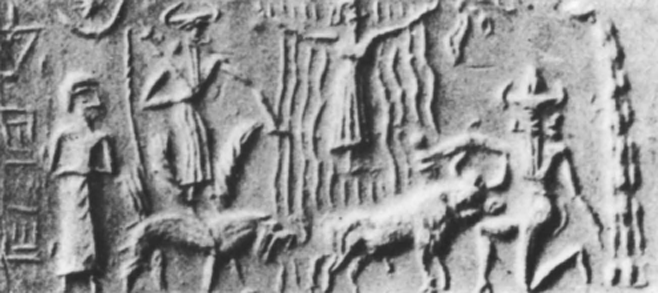
The Mitanni generally retained a naturalistic looking Panther, and some of the best early examples of these are actually of Jirift culture much further South in Iran around 2,500 BC, in the context of a constellation, Perseus.
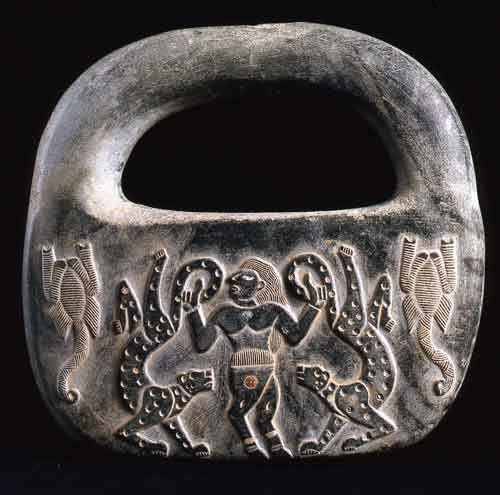
a reply to: Byrd
Yes i'm sure the association of the winged Panther with the storm Demon is well enough known to many Sumerologists and the like it was just the case that the author in the Natural Phenomena article did a very poor job in researching and recognizing it, the only important thing i have pointed out really is that the stream issuing from it's mouth was the Perseid meteor stream in terms of identification with the constellation Perseus.
a reply to: AguirreB
It does seem to be the case as punkinworks also pointed out that there was related climate change and a general destabilizing of cultures across a wide region as a result and conflict.
It seems to be the case that from the time of the Old Babylonian period within their sphere of influence that the hybrid creature replaces the naturalistic winged panther, perhaps to emphasize the ferocity of the storm Demon qualities, an early example of this seen here were the hyvrid creature is still recognizibly in the same role as the winged Panther with Ninurta upon it

The Mitanni generally retained a naturalistic looking Panther, and some of the best early examples of these are actually of Jirift culture much further South in Iran around 2,500 BC, in the context of a constellation, Perseus.

a reply to: Byrd
Yes i'm sure the association of the winged Panther with the storm Demon is well enough known to many Sumerologists and the like it was just the case that the author in the Natural Phenomena article did a very poor job in researching and recognizing it, the only important thing i have pointed out really is that the stream issuing from it's mouth was the Perseid meteor stream in terms of identification with the constellation Perseus.
a reply to: AguirreB
It does seem to be the case as punkinworks also pointed out that there was related climate change and a general destabilizing of cultures across a wide region as a result and conflict.
edit on Kam22934vAmerica/ChicagoThursday0429 by Kantzveldt because: (no reason given)
a reply to: punkinworks10
I read the paper you linked it's pretty good what they extract from some of the City Lament texts and the case they make for this triggering the overthrow of the Akkadians, but the real puzzle is their identifying the City of Akkad closest to the impact point on the shores of the gulf, the mystery being that the City of Nigin was in that location within the marshlands and served the same function they describe for Akkad, including as a trade point for Meluhhans/Indians.
The City of Nigin/Nina
I can't see the need for two cities in the same area serving the same function, and Nina was there before the Akkadians and afterward at the time of Gudea, if it is the case that Akkad should be located there then i would only conclude that they had renamed Nigin and adopted it as their capital which was then reversed post-Akkadian period, that would sort of explain why nobody has ever located it.
I read the paper you linked it's pretty good what they extract from some of the City Lament texts and the case they make for this triggering the overthrow of the Akkadians, but the real puzzle is their identifying the City of Akkad closest to the impact point on the shores of the gulf, the mystery being that the City of Nigin was in that location within the marshlands and served the same function they describe for Akkad, including as a trade point for Meluhhans/Indians.
The City of Nigin/Nina
I can't see the need for two cities in the same area serving the same function, and Nina was there before the Akkadians and afterward at the time of Gudea, if it is the case that Akkad should be located there then i would only conclude that they had renamed Nigin and adopted it as their capital which was then reversed post-Akkadian period, that would sort of explain why nobody has ever located it.
originally posted by: Byrd
a reply to: Kantzveldt
An interesting idea, but I see a few problems with it:
* the Mitanni seals date from about 1500 BC
* the presumed Umm Al Bini structure dates to a thousand years before (2400 BC)
* a meteor impact that affected a mountain would make a pretty noticeable crater - bigger than Umm Al Bini lake.
* One that obliterated a mountain would be about the size of Chixhulub (because mountains are pretty darn big an tough.)
* I don't see any reference that the Mitanni used winged panthers in their iconography. Can you supply a reference?
I can't find the seal in the British Museum (or elsewhere, but I know it exists.) Want to see if more work has been done on it.
On the other hand, I freakin' *love* the fact that your articles make me go look up the research - so take my comments more as a student's critique of another's serious paper. I've learned SO much and enjoyed the little morning hunt on this one. (I had to go look up meteors, impact craters, impact crater reports, impact crater sizes, the Mitanni, the Sumerians, Ninurta, legends, cylinder seals, and prowled some of the British Museum's online collection.)
I am sorry but no on the comparison of (Chixhulub)
Chicxulub was an impactor estimated to be nearly 6 miles in size creating a 110 Mile diameter and nearly 12 miles in depth crater. This is nearly 3 times the height of Mt Everest and wider than the largest section of the Himalayan range.
Umm al Binni lake if it is a impact crater was created by a much smaller object 800-900 feet (300meters)...not miles...
Often impacts are in chains it seems possible that could have obliterated a mountain and caused massive Tsunami
Oh
Great thread Kantz
a reply to: Kantzveldt
Any possible believe or rumors that Ninruta used or commanded Anzu to have caused such an event or was the weapon that Ninruta used to defeat in two of you earlier threads had mentioned when he was getting the tablets of destiny back from the dragon trying to change fate?
If it is the weapon then it could be symbolized as a spear, much like how the Greek god Zeus uses his lightening bolt on Typhon or when people swore to him. (Just a muse thr)
Also if we are talking about Sodom, why didn't ancient Greece or Rome get wiped out. Sodomites might have got their name from the story, which possibly inspired the whole homo phobia in monotheism.lol
Any possible believe or rumors that Ninruta used or commanded Anzu to have caused such an event or was the weapon that Ninruta used to defeat in two of you earlier threads had mentioned when he was getting the tablets of destiny back from the dragon trying to change fate?
If it is the weapon then it could be symbolized as a spear, much like how the Greek god Zeus uses his lightening bolt on Typhon or when people swore to him. (Just a muse thr)
Also if we are talking about Sodom, why didn't ancient Greece or Rome get wiped out. Sodomites might have got their name from the story, which possibly inspired the whole homo phobia in monotheism.lol
edit on 4-2-2016 by Specimen because: (no reason given)
originally posted by: Kantzveldt
The Mitanni generally retained a naturalistic looking Panther, and some of the best early examples of these are actually of Jirift culture much further South in Iran around 2,500 BC, in the context of a constellation, Perseus.
Those are leopards. The libation vase of Gudea belongs to a similar artist tradition as Jiroft, hence the leopard carry through, and the leopard/serpent/eagle hybrid combination. There are though, of course, a number of winged hybrids across the various cultures that occupied the area, and some blending, the winged panther that you associate with the Mitanni seals may be one of those, but it may not have the same associations as the leopard does. I don't know if the leopard relates to Perseus for you the same way the panther would, I thought it was Ea-bani in the centre there, he definately has the hind-quarters of a hoofed animal of some sort, centaur seems most likely.
ETA, Okay perhaps it's semantics, a panther is a leopard whose spots cannot be seen...or vice versa...so while they might have similar associations with only pigmentation differentiating them, a black leopard (panther) would have a different, possibly opposing, meaning to a spotty panther (leopard). Might well be more powerful mojo, depending on rarity, the warrior class in Southern Sumer wore a leopard pelt, I presume that was because hunters then warriors had to prove themselves by catching "Clever". Perhaps you got to be something else if you caught a panther.
edit on 4-2-2016 by Anaana because: melanistic additions
a reply to: Anaana
Could be a Leopard though they did like to put dots on most things, the word Nimru covered both Leopard and Panther, but here's the thing, was there any development of the hybrid creature before the proposed impact date, and was it therefore a development motivated by the impact event?
It might have been the case that Nimru was long associated with Perseus but no great significance associated with it, and you'll struggle before that date to find any representation of it, as you would with quite a few other of the constellations, but if the impact strikes can be considered to have originated from the Perseid stream all that changes, suddenly that beast aquires great significance, perhaps only then becomes seen as the storm Demon, and gains a great deal of symbolic baggage hence the hybrd characteristics of eagle/Anzu-Leopard-Lion.
It also becomes an important symbol of the Neo-Sumerian restoration of Gudea, after all it was that beast which facilitated the passing of the Akkadians, it isn't a mušḫuššu the early hybrid more uumu naa´iru and despite the common attempt to associate it with Ningizhida there's no real basis for that either, it more likely relates to Ningirsu, given the association seen between Ninurta and the beast, and the fact it had the rear quarters of an Eagle and front paws of a lion like the Anzu bird also closely related to Ninurta.
It may also have been the case that after the impact event the Leopard was considered more appropriate to represent the Nimru basis for the beast simply because of it's dots...
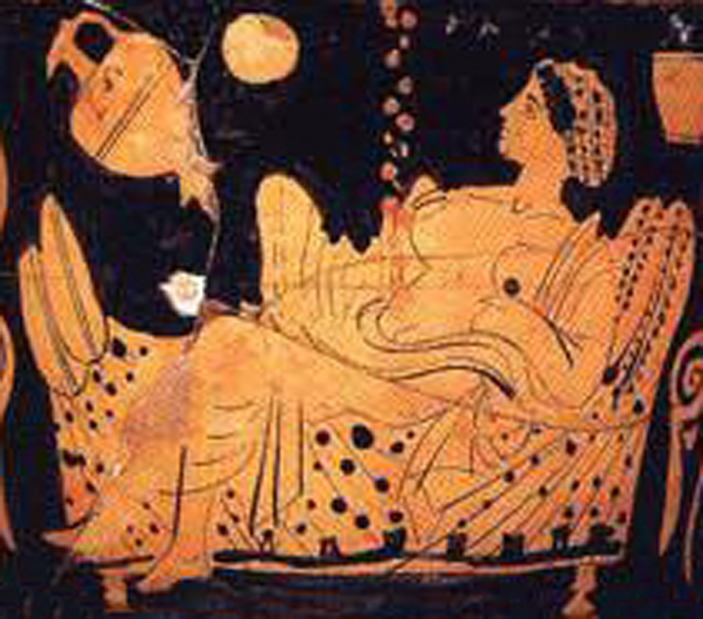
a reply to: Specimen
I think as i've just mentioned above that given the association of the Anzu with the principles of aerial might and Celestial enforcement you do start to see the Anzu incorporated into the hybrid symbolism of the storm Demon.
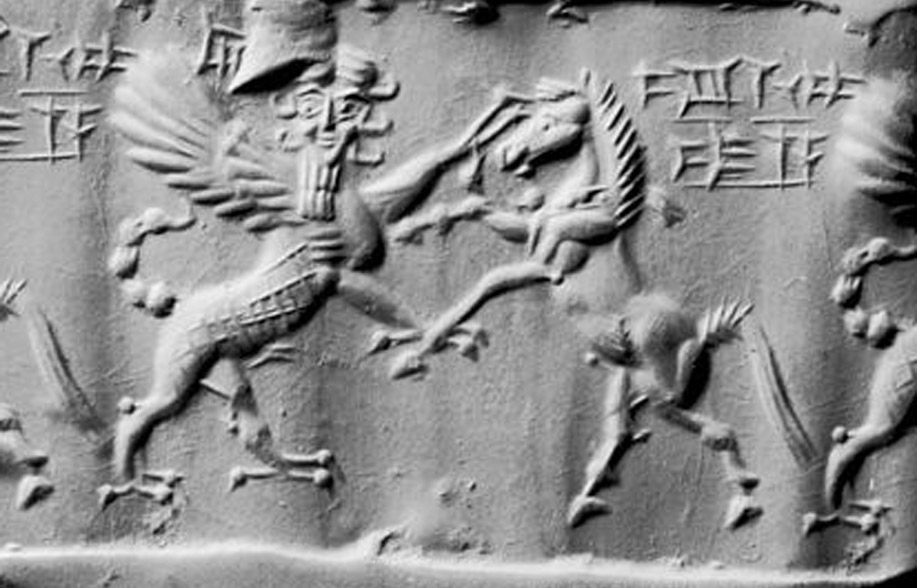
Could be a Leopard though they did like to put dots on most things, the word Nimru covered both Leopard and Panther, but here's the thing, was there any development of the hybrid creature before the proposed impact date, and was it therefore a development motivated by the impact event?
It might have been the case that Nimru was long associated with Perseus but no great significance associated with it, and you'll struggle before that date to find any representation of it, as you would with quite a few other of the constellations, but if the impact strikes can be considered to have originated from the Perseid stream all that changes, suddenly that beast aquires great significance, perhaps only then becomes seen as the storm Demon, and gains a great deal of symbolic baggage hence the hybrd characteristics of eagle/Anzu-Leopard-Lion.
It also becomes an important symbol of the Neo-Sumerian restoration of Gudea, after all it was that beast which facilitated the passing of the Akkadians, it isn't a mušḫuššu the early hybrid more uumu naa´iru and despite the common attempt to associate it with Ningizhida there's no real basis for that either, it more likely relates to Ningirsu, given the association seen between Ninurta and the beast, and the fact it had the rear quarters of an Eagle and front paws of a lion like the Anzu bird also closely related to Ninurta.
It may also have been the case that after the impact event the Leopard was considered more appropriate to represent the Nimru basis for the beast simply because of it's dots...

a reply to: Specimen
I think as i've just mentioned above that given the association of the Anzu with the principles of aerial might and Celestial enforcement you do start to see the Anzu incorporated into the hybrid symbolism of the storm Demon.

edit on Kpm22934vAmerica/ChicagoThursday0429 by Kantzveldt because: (no reason given)
originally posted by: AguirreB
This is simply fascinating, while doing some basic research I came across this:
www.news.cornell.edu...
Using “dendro radiocarbon wiggle matching" they were able to pinpoint a rough date of when this event occurred, 2200 B.C.
Right around the same time as this paper suggests..
I wonder if it could have been a volcanic eruption in the mountain, like Krakatoa?
Here's another eruption in 2200BC
www.volcanolive.com...
new topics
-
OK this is sad but very strange stuff
Paranormal Studies: 1 hours ago -
Islam And A Book Of Lies
Religion, Faith, And Theology: 2 hours ago -
Sorry to disappoint you but...
US Political Madness: 5 hours ago -
Watch as a 12 million years old Crab Emerges from a Rock
Ancient & Lost Civilizations: 9 hours ago
top topics
-
Sorry to disappoint you but...
US Political Madness: 5 hours ago, 13 flags -
Just Sick of It! Done! Can't take it anymore!
General Chit Chat: 17 hours ago, 9 flags -
ILLUMINATION: Dimensions / Degrees – Da Vincis Last Supper And The Philosophers Stone
Secret Societies: 16 hours ago, 9 flags -
Watch as a 12 million years old Crab Emerges from a Rock
Ancient & Lost Civilizations: 9 hours ago, 9 flags -
OK this is sad but very strange stuff
Paranormal Studies: 1 hours ago, 4 flags -
Islam And A Book Of Lies
Religion, Faith, And Theology: 2 hours ago, 1 flags
active topics
-
Musk calls on King Charles III to dissolve Parliament over Oldham sex grooming gangs
Mainstream News • 179 • : NoCorruptionAllowed -
What Is 'Quad Demic'? Mask Mandate Returns In These US States
Diseases and Pandemics • 39 • : AdultMaleHumanUK -
Meta Llama local AI system is scary good
Science & Technology • 38 • : glend -
Sorry to disappoint you but...
US Political Madness • 13 • : nugget1 -
OK this is sad but very strange stuff
Paranormal Studies • 2 • : Ravenwatcher -
Winter Storm
Fragile Earth • 33 • : rickymouse -
Stuck Farmer And His Queue Jumping Spawn
Rant • 5 • : rickymouse -
Speaking of Pandemics
General Conspiracies • 4 • : rickymouse -
Trump's idea to make Canada the 51st US state: 'Potential is massive'
Mainstream News • 154 • : WeMustCare -
DONALD J. TRUMP - TIME's Most Extraordinary Person of the Year 2024.
Mainstream News • 62 • : WeMustCare
